

Eurofighter Typhoon. The aircraft's development effectively began in 1983 with the Future European Fighter Aircraft programme, a multinational collaboration among the UK, Germany, France, Italy and Spain.
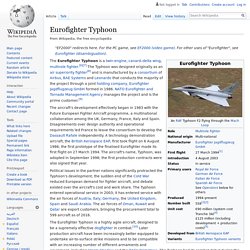
Disagreements over design authority and operational requirements led France to leave the consortium to develop the Dassault Rafale independently. A technology demonstration aircraft, the British Aerospace EAP, first took flight on 6 August 1986; the first prototype of the finalised Eurofighter made its first flight on 27 March 1994. The aircraft's name, Typhoon, was adopted in September 1998; the first production contracts were also signed that year. Political issues in the partner nations significantly protracted the Typhoon's development; the sudden end of the Cold War reduced European demand for fighter aircraft, and debate existed over the aircraft's cost and work share.
Development[edit] Origins[edit] Official Eurofighter logo Delays[edit] RAF Typhoon FGR4 ZK356 shows off its delta wing, July 2016 No. Oman. British Aerospace Harrier II. The British Aerospace Harrier II is a second-generation vertical/short takeoff and landing (V/STOL) jet aircraft used previously by the Royal Air Force (RAF) and, between 2006 and 2010, the Royal Navy (RN).
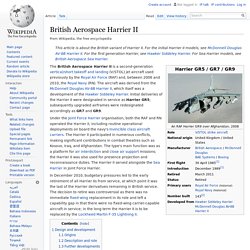
The aircraft was derived from the McDonnell Douglas AV-8B Harrier II, which itself was a development of the Hawker Siddeley Harrier. Initial deliveries of the Harrier II were designated in service as Harrier GR5; subsequently upgraded airframes were redesignated accordingly as GR7 and GR9. Under the Joint Force Harrier organisation, both the RAF and RN operated the Harrier II, including routine operational deployments on board the navy's Invincible class aircraft carriers. The Harrier II participated in numerous conflicts, making significant contributions in combat theatres such as Kosovo, Iraq, and Afghanistan.
Design and development[edit] Origins[edit] Description and role[edit] RAF Harrier GR9 in flight, 2010 Further developments[edit] Operational history[edit] No. 38 Squadron RAAF. After being re-equipped with de Havilland Canada DHC-4 Caribous in 1964, No. 38 Squadron served as the RAAF's operational conversion unit for the type and also conducted transport tasks within Australia and its territories.
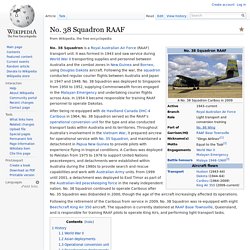
Throughout Australia's involvement in the Vietnam War, it prepared aircrew for operational service with No. 35 Squadron, and maintained a detachment in Papua New Guinea to provide pilots with experience flying in tropical conditions. A Caribou was deployed to Pakistan from 1975 to 1978 to support United Nations peacekeepers, and detachments were established within Australia during the 1980s to provide search and rescue capabilities and work with Australian Army units. From 1999 until 2001, a detachment was deployed to East Timor as part of the Australian-led peacekeeping force in the newly independent nation. No. 38 Squadron continued to operate Caribous after No. 35 Squadron was disbanded in 2000, though the age of the aircraft increasingly affected its operations. Beechcraft Super King Air. The Beechcraft Super King Air family is part of a line of twin-turboprop aircraft produced by Beechcraft.
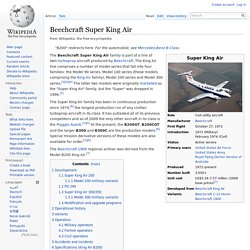
The King Air line comprises a number of model series that fall into four families: the Model 90 series, Model 100 series (these models comprising the King Air family), Model 200 series and Model 300 series.[2][3][4] The latter two models were originally marketed as the "Super King Air" family, but the "Super" was dropped in 1996.[5] The Super King Air family has been in continuous production since 1974,[6] the longest production run of any civilian turboprop aircraft in its class.
Attack aircraft. An attack aircraft (also called a strike aircraft or attack bomber) is a tactical military aircraft that has a primary role of carrying out airstrikes with greater precision than bombers, and is prepared to encounter strong low-level air defenses while pressing the attack.[1] This class of aircraft is designed mostly for close air support and naval air-to-surface missions, overlapping the tactical bomber mission.

Designs dedicated to non-naval roles are often known as ground-attack aircraft.[2] Fighter aircraft often carry out the attack role although they would not be considered attack aircraft per se, although fighter-bomber conversions of those same aircraft would be considered part of the class. Strike fighters, which have effectively replaced the fighter-bomber and light bomber concepts, also differ little from the broad concept of an attack aircraft. The dedicated attack aircraft as a separate class existed primarily during and after World War II. Aeritalia G.222. The Aeritalia G.222 (formerly Fiat Aviazione, later Alenia Aeronautica) is a medium-sized STOL military transport aircraft.
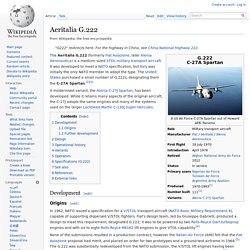
It was developed to meet a NATO specification, but Italy was initially the only NATO member to adopt the type. The United States purchased a small number of G.222s, designating them the C-27A Spartan.[2][3] A modernised variant, the Alenia C-27J Spartan, has been developed. While it retains many aspects of the original aircraft, the C-27J adopts the same engines and many of the systems used on the larger Lockheed Martin C-130J Super Hercules. Development[edit] Origins[edit] In 1962, NATO issued a specification for a V/STOL transport aircraft (NATO Basic Military Requirement 4), capable of supporting dispersed V/STOL fighters. Lockheed Martin C-130J Super Hercules. The Lockheed Martin C-130J Super Hercules is a four-engine turboprop military transport aircraft.
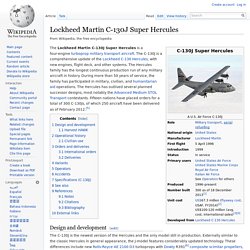
The C-130J is a comprehensive update of the Lockheed C-130 Hercules, with new engines, flight deck, and other systems. The Hercules family has the longest continuous production run of any military aircraft in history. During more than 50 years of service, the family has participated in military, civilian, and humanitarian aid operations. The Hercules has outlived several planned successor designs, most notably the Advanced Medium STOL Transport contestants. Fifteen nations have placed orders for a total of 300 C-130Js, of which 250 aircraft have been delivered as of February 2012[update].[5] Design and development[edit] Alenia C-27J Spartan. "C-27 Spartan" redirects here.
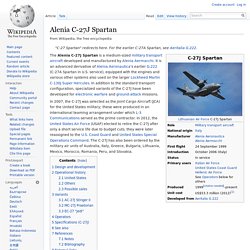
For the earlier C-27A Spartan, see Aeritalia G.222. The Alenia C-27J Spartan is a medium-sized military transport aircraft developed and manufactured by Alenia Aermacchi. It is an advanced derivative of Alenia Aeronautica's earlier G.222 (C-27A Spartan in U.S. service), equipped with the engines and various other systems also used on the larger Lockheed Martin C-130J Super Hercules.
General Dynamics F-111 Aardvark. The General Dynamics F-111 Aardvark was a supersonic, medium-range interdictor and tactical Attack aircraft that also filled the roles of strategic bomber, aerial reconnaissance, and electronic-warfare aircraft in its various versions.
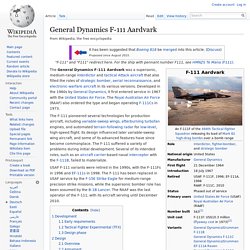
Developed in the 1960s by General Dynamics, it first entered service in 1967 with the United States Air Force. The Royal Australian Air Force (RAAF) also ordered the type and began operating F-111Cs in 1973. The F-111 pioneered several technologies for production aircraft, including variable-sweep wings, afterburning turbofan engines, and automated terrain-following radar for low-level, high-speed flight. Its design influenced later variable-sweep wing aircraft, and some of its advanced features have since become commonplace. The F-111 suffered a variety of problems during initial development. Airbus A400M Atlas. General Dynamics F-111 Aardvark. The General Dynamics F-111 Aardvark was a supersonic, medium-range interdictor and tactical Attack aircraft that also filled the roles of strategic bomber, aerial reconnaissance, and electronic-warfare aircraft in its various versions.
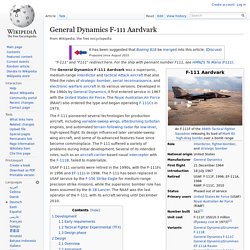
Developed in the 1960s by General Dynamics, it first entered service in 1967 with the United States Air Force. The Royal Australian Air Force (RAAF) also ordered the type and began operating F-111Cs in 1973. The F-111 pioneered several technologies for production aircraft, including variable-sweep wings, afterburning turbofan engines, and automated terrain-following radar for low-level, high-speed flight.
Its design influenced later variable-sweep wing aircraft, and some of its advanced features have since become commonplace. The F-111 suffered a variety of problems during initial development. Lockheed C-130 Hercules. The Lockheed C-130 Hercules is a four-engine turboprop military transport aircraft designed and built originally by Lockheed, now Lockheed Martin. Capable of using unprepared runways for takeoffs and landings, the C-130 was originally designed as a troop, medical evacuation, and cargo transport aircraft.
The versatile airframe has found uses in a variety of other roles, including as a gunship (AC-130), for airborne assault, search and rescue, scientific research support, weather reconnaissance, aerial refueling, maritime patrol, and aerial firefighting. It is now the main tactical airlifter for many military forces worldwide. Over 40 models and variants of the Hercules serve with more than 60 nations. Aermacchi MB-326. Design and development[edit] CAC Winjeel. The CAC CA-25 Winjeel (aboriginal for young eagle[1]) entered service with the Royal Australian Air Force in 1955 as an ab-initio to advanced training aircraft. Design and development[edit] Service[edit] The first Winjeel entered service with No.1 Basic Flight Training School (BFTS) at Uranquinty, near Wagga Wagga, New South Wales.
For most of the service life of the Winjeel it was used as a basic-training aircraft at RAAF Base Point Cook in Victoria. Alenia C-27J Spartan. "C-27 Spartan" redirects here. For the earlier C-27A Spartan, see Aeritalia G.222. The Alenia C-27J Spartan is a medium-sized military transport aircraft. The C-27J is an advanced derivative of Alenia Aeronautica's G.222 (C-27A Spartan in U.S. service), with the engines and systems of the Lockheed Martin C-130J Super Hercules. The aircraft was selected as the Joint Cargo Aircraft (JCA) for the United States military, for which L3 is the prime contractor. The C-27J has also been ordered by the military air units of Australia, Italy, Greece, Bulgaria, Lithuania, Mexico, Morocco, Romania and Peru.
Design and development[edit] In 1995, Alenia and Lockheed Martin began discussions to improve Alenia's G.222 using C-130J's glass cockpit and a more powerful version of the G.222's T64G engine and four-blade propellers. By 2005, the U.S. The LMATTS joint venture was later dissolved when Lockheed Martin chose to offer the C-130J in 2006 as a contender in the same U.S. Operational history[edit] RAF Brize Norton - Voyager K2/K3. Airbus A330 MRTT. The Airbus A330 Multi Role Tanker Transport (MRTT) is an aerial refuelling tanker aircraft based on the civilian Airbus Airbus A330.
The A330 MRTT has been ordered by the Royal Australian Air Force (RAAF), Royal Air Force (RAF), United Arab Emirates Air Force, Royal Saudi Air Force and Republic of Singapore Air Force. Airbus A400M Atlas. The Airbus A400M Atlas[3][4] is a multi-national four-engine turboprop military transport aircraft. It was designed by Airbus Military as a tactical airlifter with strategic capabilities.[5] The aircraft's maiden flight, originally planned for 2008, took place on 11 December 2009 from Seville, Spain.[1] A total of 174 A400M aircraft have been ordered by eight nations as of July 2011.[6] The A400M received certification in March 2013.
F-35A Lightning II. The F-35A provides Australia with a fifth generation aircraft capability to enable air superiority into the future. Australia has committed to 72 F-35A aircraft – comprised of three operational squadrons - two at RAAF Base Williamtown and one at RAAF Base Tindal. In addition, a training squadron will be based at RAAF Base Williamtown. F/A-18F Super Hornet - Royal Australian Air Force. E-7A Wedgetail - Royal Australian Air Force. The E-7A Wedgetail represents an entirely new capability for the ADF, providing an airborne early warning and control (AEW&C) platform that will gather information from a wide variety of sources, analyse it and distribute it to all friendly air and surface assets.